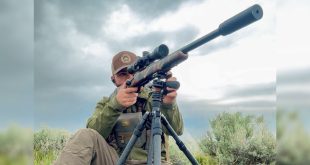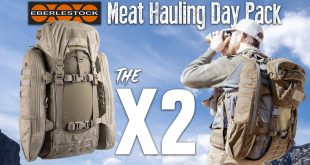
When it comes to pack weight, I’d be willing to bet that every seasoned backpack hunter out there has gone through some major changes over the years. I guess you could call these “evolutions or phases,” and I’d also be willing to bet that each person hit each evolution at about the same time in their backpack hunting career! Some of the changes will be made because of budget, some from experience (bad and good), others from pain and the most important would be those times that you almost die because of what you did or did not put inside your pack. All of these are important, but again, I’d bet almost everyone mirrors each other to a certain degree, and keeping things simple has probably won the day in the end.

I’ll go ahead and give a title for some of these phases along with examples:
The poverty phase – This is pretty self-explanatory, and the final result is a very heavy pack that is great for building character and toughness, but horrible for comfort.
The divorce phase – As you can imagine, this phase is 100% the result of fixing the first phase, but you about get divorced from spending money on lighter weight gear.
The Q phase – The reason I’m calling this the Q phase is because you’re financially stable, and you’re buying every gimmicky piece of gear on the market … like Q from 007 designed it to save weight.
The weight weenie phase – I’ve come to hate the people in this phase, even though I was one of them several years ago … and here’s why. They have enough experience to be successful and enough knowledge to get their pack weight down to a ridiculously low weight, but probably haven’t come close to death yet from gear failure or leaving gear at home.
The WTF-was-I-thinking phase – Like the title says, this is where you look back at the last couple phases and smack yourself for being so stupid.
The keep-it-simple phase – This is the phase where you forget about spreadsheets and sales gimmicks and just load what you need into the pack; whatever the weight ends up being is what it ends up being. This isn’t because you’re not worried about what the pack weighs, but because you know what you need from experience and trust what you’ve learned over time.
I’m sure there’s several variations to the phases I’ve listed above, and they may be in different orders, but what I’m hoping to do in this article is to get you to the last phase on the list—to where you’re confident with not only your gear list, but the actual items on that list and keep you away from divorce, danger on the mountain side, back pain and focused on the task at hand.
There’s nothing wrong with having a packing list and going over it with a fine-tooth comb, but without a lot of experience, you’re really only guessing at what you should be going over. You want your pack to consist of the lightest-weight options you can find without jeopardizing your safety, comfort or the hunt (within reason anyway). Below, I will go over a list of common issues beginning backpack hunters will have and how to get ahead of these problems before your pack ends up weighing 90 lbs. or you starve yourself to death.

Overpacking – This, in my opinion, is the most common issue with beginning backpack hunters. This doesn’t mean the gear they purchased is too heavy, but because they have packed WAY more than they need. Clothing, for example, can be an overpacking nightmare for most beginners. To a beginner, the idea of only bringing one extra set of underwear and socks for a multi-day hunt will sound horrible. Other likely culprits are batteries, unneeded medical items, heavy knives, hatchets, Wyoming saws and a long list of others. Below, I will list a rough idea of what you’ll be looking at to help simplify things when packing for your next trip.
Sleep system (sleeping bag, pad and shelter) – A decent sleep system that can handle any normal to relatively-extreme conditions should weigh between 4.5-6.5 lbs. Any more than that, and you’re probably packing more than you need; any less, and durability and comfort could, and eventually will, come into play.
Cooking system – There are about a thousand different choices on the market today when it comes to stoves, but there’s no need to over complicate this one! Stay away from the UL alcohol/ beer-can stoves as well as the heavy, but durable, multi-fuel stoves, and pick out one of the many Isobutane stoves on the market. Keep your target weight between 14 and 20 ounces, including fuel and spoon. This shouldn’t be too difficult, but make sure you’re getting a model that’s dependable with a lot of good reviews.
First aid – You definitely want to be real for emergency medical situations, but knowledge and training will save you a lot of pack weight in the end. Things like Leukotape, Duct Tape, ibuprofen, surgical glue and some combat gauze will get you through almost anything and don’t weigh a whole lot. Just make sure your first-aid skills are up to snuff, and you’ll save a lot of weight. I’m not suggesting you go as spartan as I do, but my kit weighs in at 8 ounces, and that includes extra contacts, migraine pills, ibuprofen, surgical glue, combat gauze and a few other small items. This system has kept me out of harm’s way for many years, and I don’t see it changing anytime soon.
Clothing – Most seasoned wilderness hunters are going to have about the exact same layering/clothing system in their pack. This will consist of a base layer, fleece layer, insulating jacket, rain gear, gloves and stocking cap. They will probably have an extra set of socks and underwear, at most, and definitely won’t be packing in multiple sets of anything else. With the technology we have at our fingertips today, heavy wool clothing and cotton are things of the past, and the tech style systems will offer a significant amount of savings in pack weight, dry much faster and still keep the smell down to a minimum.
Food – This isn’t something that is a love/hate relationship for me! I love eating, but hate the weight it adds to the pack. The amount each person brings will vary from one to the next, but anywhere from 2,800-3,500 calories a day should work for just about anyone. You do want to make sure and stay at a minimum of 100 calories per ounce and more if possible. This will obviously end up adding around 2 lbs. per day of pack weight, but fueling the machine is important, and you don’t want to starve yourself while you’re back there. I would strongly suggest you try everything before you head out, and make sure that you actually like eating what is being put inside your pack.

Those are just a few of the big-picture items, but there are several other tricks of the trade that will help keep your pack weight down.
Make sure as many of your electronic items as possible use the same batteries and all of them have a new set in before you leave. This will be most important when something runs out of juice, and you can rob the batteries from a lesser-used item in an emergency. Also, use high-performance lithium batteries in all of your electronics. This will keep you from bringing extra batteries a lot of times, and it does save money in the long run, too.
Everything in your pack should serve at least two purposes, so if it’s only got one use, you should probably drop it from the list. For example, a dry sack can also be used as a pillow, water storage, food storage and many other things. Super Glue is great for an archery repair kit, but works for gluing together cuts and doing field repairs on gear in a jamb. Just keep an open mind, stay resourceful and get the most out of every piece of gear you can.
This won’t save a ton of weight, but every ounce counts, so cut off anything unneeded and extra from any and all the gear in your pack. Make sure you don’t need it before you start hacking away, but you’d be surprised at how much weight can be saved with a knife, scissors and a lighter.
You won’t be able to use this tip until you’ve been on a few trips into the wild, but keep a list of everything you’ve used that’s on your gear list, and if there are things that aren’t being used, get them off the list!
Water filters can be handy at times, but they are heavy and bulky! Try and use tablets or drops if you’re really trying to save weight, and if filtering is needed, use a bandana or t-shirt to help keep debris out. The SteriPEN is one of my favorites, and they’re about half the weight of a pump.
Knowledge and field craft will save the most weight of all, so get out into the wilderness and start learning!
In closing, I’d like to mention that these are rough numbers that I’ve listed above, and you can definitely go much lighter than I’ve recommended. That being said, going lighter can cause a lot of issues when the weather turns bad, your hunt gets extended and a multitude of other issues that can arise. You want to have some level of comfort while you’re out there, and 3-5 extra lbs. of pack weight in either direction can change things drastically; you want to be happy on the hike in, the time you’re there and the hike back out!
 Eastmans' Official Blog | Mule Deer, Antelope, Elk Hunting and Bowhunting Magazine | Eastmans' Hunting Journals
Eastmans' Official Blog | Mule Deer, Antelope, Elk Hunting and Bowhunting Magazine | Eastmans' Hunting Journals





One comment
Pingback: Simplicity Afield – Common Sense Backpack Hunting « Dalelorenzo's GDI Blog